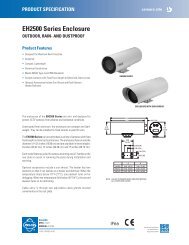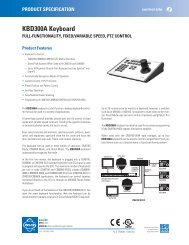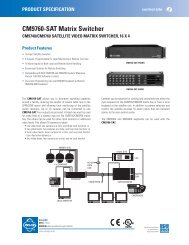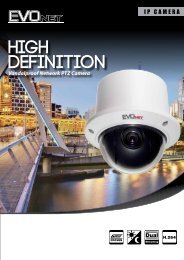Chapter 1 - Pacific Communications
Chapter 1 - Pacific Communications
Chapter 1 - Pacific Communications
Create successful ePaper yourself
Turn your PDF publications into a flip-book with our unique Google optimized e-Paper software.
User’s Manual<br />
− Service Option: Selecting a service from the service list and Service Option allows you to set up<br />
the information for connection to the selected service.<br />
• Service Port: Enter the port number for connection to<br />
the selected service.<br />
• Callback Port: Enter the port number to receive a<br />
callback message from the device (supported only for the<br />
monitoring service). The port number you enter should<br />
match the port number set on the device for remote<br />
callback.<br />
• Alarm In Port: Set up the port number to receive text<br />
strings for user alarm in event detection (supported only<br />
for the monitoring service). Refer to <strong>Chapter</strong> 11 —<br />
Device Management, User Alarm In Event Setup<br />
(p. 94) for details about the user alarm in event.<br />
• RTP Incoming Port Range: Enter the port range if a<br />
device which transmits images using the RTP protocol<br />
is registered (supported only for recording or streaming<br />
services). Port range settings must be changed if the<br />
network firewall or local network allows only specific<br />
UDP/RTP port numbers. The port numbers should not<br />
conflict with the RTP port numbers of Client system or<br />
port numbers of other streaming programs. If an RTP<br />
port number conflicts with others, recording and streaming<br />
may not be available.<br />
• Log: Selecting Show Log allows you to check and search the system log.<br />
Setting up the time range of the log and clicking<br />
the Search button displays the log information.<br />
Selecting First displays from the oldest log entries<br />
regardless of date. Selecting Last displays to the<br />
newest log entries regardless of date.<br />
Status Display<br />
• Service: Displays the list of services supported by the NVR system.<br />
− Administration Service: Manages information of services, devices, users and schedules for operating<br />
the SiRiS program. When the administration service is not working, the SiRiS program does not work.<br />
− Recording Service: Records video transmitted from the network video device. When the recording<br />
service is not working, the SiRiS program does work but the system will not record and playback of<br />
previously recorded video will not be available.<br />
− Monitoring Service: Notifies live events and callback events detected at the device registered in the<br />
NVR system to the Client system.<br />
− Streaming Service: Streams images from devices to multiple client systems simultaneously.<br />
• Status: Displays the working status of each service.<br />
− Working: Indicates the service is working properly. You can operate the SiRiS Setup and SiRiS<br />
Client program, and the system performs recording based on the recording schedule.<br />
− Failed: Indicates the service failed to run because of an unknown problem. The system restarts the<br />
services or reboots the system based on the Watchdog settings. Refer to Menu (p. 19) for details about<br />
Watchdog settings.<br />
• CPU Usage: Displays the CPU usage of each service.<br />
20
















